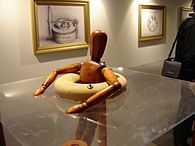Lifebuoy
A lifebuoy is a lifebuoy in the water rescue service . It is often used in indoor or outdoor swimming pools , but is also used in bodies of water and is standard on ships and larger boats, whereby it is usually clearly legible with the ship's name and usually also the home port. With fishing boats often comes fisheries mark it. In contrast, a ring-shaped swimming aid as a learning or play device is referred to as a swimming ring or swimming ring . Lifebuoys are hollow or filled with foam. Cork rings covered with canvas and painted were also common on ships.
handling
With a leash
Lifebelts with linen be held at the end of the line and the ring in the centrifugal casting about kicked the to be rescued, the ring can be drawn yet for accident victims.
Advantages:
- Easy to use
- ready for use quickly
Disadvantage:
- Only possible with awareness
- limited operating range
Without a leash
The lifebuoy must be thrown towards the casualty with the throwing throw, but cannot be led towards the casualty.
Advantage:
- Available (almost) everywhere
- no harm to the rescuer
Disadvantage:
- Difficult to use
- Greater risk to the casualty
- A lot of practice is needed
- Only possible with awareness
Savior in the water
The lifeguard swims towards the casualty with the lifebuoy. He places the upper arms of the casualty on the ring and transports him back to the bank or the edge of the pool.
Advantages:
- Available (almost) everywhere
- Also possible with unconscious people
Disadvantage:
- A lot of practice is needed
- Rescuer must go into the water (safety aspects)
history
The first draft of a lifebuoy is said to go back to Leonardo da Vinci (15th century).
Alternatives
As an alternative to the classic lifebuoy, alternative forms of lifebuoy, also known under the name “lifebuoy”, are used today, especially on sports boats. Horseshoe-shaped open rings have the advantage that the person in the water can dress them better. Tie-on solid lifeguards also keep the person afloat if they lose consciousness. Rescue or rescue loops are placed under the arms and enable a person to be easily rescued from the water. This equipment is kept ready on the ship's pushpit, along with a floating line that is as long as possible, so that it can be thrown immediately if someone should go overboard. The line is wound up so that it unwinds by itself.
Rescue balls are foam balls or cubes that can be thrown into the water in a net on a line. They are easier to hold on to than lifebuoys and can be thrown further. Similar to the lifebuoy, they are mainly used to rescue people from the bank.
Rescue poles are still sometimes used in swimming pools.
As a preventive measure - the best protection against drowning is always not to fall into the water in the first place - life belts are worn. These are harnesses for sailors with which they tie themselves to the ship. Together with a life jacket , they offer the best possible protection against drowning. A modern life jacket with a collar - others may no longer be called life jackets - turn the person on their back so that they do not drown even if they are unconscious.
A survival suit can also be worn when driving in cold water . It protects against rapid hypothermia , but can massively restrict freedom of movement.
Legal protection
Removing or damaging lifebuoys can be punished with up to two years imprisonment according to StGB § 145 Abs. 2 Impairment of accident prevention and emergency aid .
literature
- Seamanship. Yachting manual. Delius Klasing Verlag , Bielefeld 2011, ISBN 978-3-7688-3248-9 (28th edition), pages 356ff
- Keith Colwell: Safety at Sea ; Delius Klasing Verlag; Bielefeld 2012 ISBN 978-3-7688-3539-8
Web links
- 327 rings that save lives. Der Tagesspiegel on May 17, 2015 about the theft of lifebuoys in Berlin. Retrieved October 24, 2016.
- DIN EN ISO 12401 (PDF, 704 kB)



